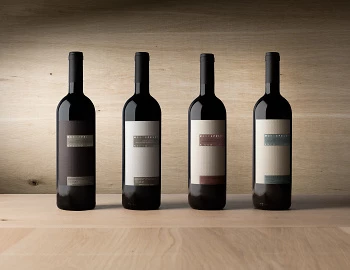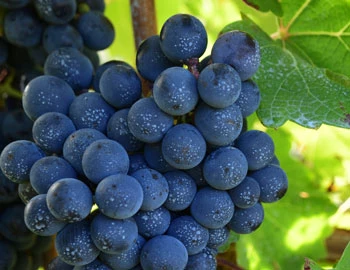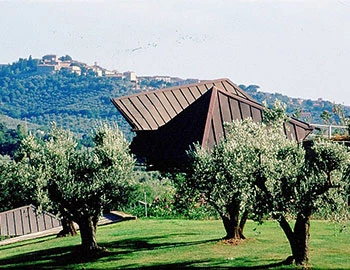
A Quo 2022
IGT Toscana, Montepeloso, 750 ml

| Grape variety: | Sangiovese, Malvasia Nera, Cabernet Sauvignon |
| Producer: | Montepeloso |
| Origin: | Italy / Toscana |
Description
This is the fresh, youthful go-getter among Montepeloso's wines. The cuvée of local and international varieties, all from younger vineyards and yet already bearing all the virtues of Montepeloso, is a wine that is approachable early on. Intense notes of blackberries and cherry, roses and Mediterranean herbs accompany the bouquet. A playful fruitiness as well as spicy and mineral notes caress the palate. A powerful wine, but without being opulent or heavy, which is an excellent accompaniment to a light-hearted tavolata.
Attributes
| Origin: | Italy / Toscana |
| Grape variety: | Sangiovese, Malvasia Nera, Cabernet Sauvignon |
| Ripening potential: | 1 to 6 years |
| Drinking temperature: | 16 to 18 °C |
| Food Pairing: | Bistecca fiorentina, T-Bone steak, Spiced grillades, Wild boar entrecôte with Spätzli, Roasted lamb gigot, Beef Stroganoff, Salad with vegetables, pulses, pasta |
| Vinification: | long must fermentation, fermentation of entire grape, partly destemmed, fermentation in wooden barrel |
| Harvest: | hand-picking, in small boxes |
| Maturation: | in steel tank, in partly new and used barriques/ Pièces |
| Bottling: | filtration |
| Maturation duration: | 6 months |
| Volume: | 13.5 % |
| Note: | Contains sulphites |
Montepeloso
The Montepeloso winery, located in Maremma, owned by Swiss co-proprietor and estate manager Fabio Chiarelotto, has earned a reputation for outstanding red wines. With a combination of mostly traditional and indigenous grape varieties, but also international varieties such as Cabernet Sauvignon, complex wines with a Mediterranean character are produced. This Tuscan gem is hidden in the hills of Suvereto, near the Tyrrhenian coast — one of the hottest areas of Tuscany.
Montepeloso spans 30 hectares, of which 15 are planted with vines. The terroir in the valley near Suvereto, around four kilometres from the Tyrrhenian coast, between the fertile alluvial soil in the plain and the barren valley flanks, offers the vines exciting conditions. Here, in one of the hottest areas of Tuscany, land and sea alternate. The thermals and coastal winds caused by the strong sunlight and the nature of the soil have a welcome cooling effect on the grapes. This keeps them fresh despite the Tuscan sun, which is reflected not least in the pronounced salinity of the wines. The highly mineral soils of the Colline Metallifere and the spicy notes of the Mediterranean scrub characterise the wines, giving them an unmistakable character of origin. The wines of Montepeloso are known for their power, but also for their elegance, structure and finesse, which makes them sought-after representatives of the Tuscan wine tradition.

Montepeloso
The Montepeloso winery, located in Maremma, owned by Swiss co-proprietor and estate manager Fabio Chiarelotto, has earned a reputation for outstanding red wines. With a combination of mostly traditional and indigenous grape varieties, but also international varieties such as Cabernet Sauvignon, complex wines with a Mediterranean character are produced. This Tuscan gem is hidden in the hills of Suvereto, near the Tyrrhenian coast — one of the hottest areas of Tuscany.
Montepeloso spans 30 hectares, of which 15 are planted with vines. The terroir in the valley near Suvereto, around four kilometres from the Tyrrhenian coast, between the fertile alluvial soil in the plain and the barren valley flanks, offers the vines exciting conditions. Here, in one of the hottest areas of Tuscany, land and sea alternate. The thermals and coastal winds caused by the strong sunlight and the nature of the soil have a welcome cooling effect on the grapes. This keeps them fresh despite the Tuscan sun, which is reflected not least in the pronounced salinity of the wines. The highly mineral soils of the Colline Metallifere and the spicy notes of the Mediterranean scrub characterise the wines, giving them an unmistakable character of origin. The wines of Montepeloso are known for their power, but also for their elegance, structure and finesse, which makes them sought-after representatives of the Tuscan wine tradition.

Montepeloso
The Montepeloso winery, located in Maremma, owned by Swiss co-proprietor and estate manager Fabio Chiarelotto, has earned a reputation for outstanding red wines. With a combination of mostly traditional and indigenous grape varieties, but also international varieties such as Cabernet Sauvignon, complex wines with a Mediterranean character are produced. This Tuscan gem is hidden in the hills of Suvereto, near the Tyrrhenian coast — one of the hottest areas of Tuscany.
Montepeloso spans 30 hectares, of which 15 are planted with vines. The terroir in the valley near Suvereto, around four kilometres from the Tyrrhenian coast, between the fertile alluvial soil in the plain and the barren valley flanks, offers the vines exciting conditions. Here, in one of the hottest areas of Tuscany, land and sea alternate. The thermals and coastal winds caused by the strong sunlight and the nature of the soil have a welcome cooling effect on the grapes. This keeps them fresh despite the Tuscan sun, which is reflected not least in the pronounced salinity of the wines. The highly mineral soils of the Colline Metallifere and the spicy notes of the Mediterranean scrub characterise the wines, giving them an unmistakable character of origin. The wines of Montepeloso are known for their power, but also for their elegance, structure and finesse, which makes them sought-after representatives of the Tuscan wine tradition.

Sangiovese
Epitome of Tuscany
Chianti classico, Brunello di Montalcino, Vino nobile di Montepulciano: the Sangiovese is in each of the classic red wines from Tuscany. For a long time, it was assumed that its birthplace was here. After all, it appeared under various synonyms in Tuscan documents dating from 1600. But in 2004, researchers unveiled that one of its parents originated in Calabria in southern Italy. Today, it is the most planted variety in Italy. In addition to Tuscany, it fares well in Emilia-Romagna, Marche or Umbria. It is an exceptionally lovable wine: its aromas of cherry and plum, violets and spices are complemented by fresh acidity and a juicy texture. It wins people around both as cheerful, drinkable wines with pizza and pasta and as barrel-aged top class wines. Carried by Italian immigrants, it found its way to California and Argentina. However, it does not have the same reputation there.

Cabernet Sauvignon
The backbone of Bordeaux
The Cabernet Sauvignon gives the Bordeaux its backbone, yielding deep violet wines with powerful tannins and endless ripening potential. It is the top dog in Médoc, and is placed in all five premier crus of Bordelais. When young, it often appears strict and unapproachable, but with advancing years, its tannins round off. It is wonderfully velvety, and yet always maintains its freshness. Typical flavours include cassis, graphite and cedar. Wherever Cabernet Sauvignon is found, Merlot is not far away. It complements the robust structure of Cabernet with softness, fruit and richness. The Cabernet Sauvignon is the most-exported vine in the world. It delivers persuasive qualities in Italy as an ingredient of the Super Tuscan, or as the flagship variety from California. There, it is lovingly titled “Cab Sauv”. Meat fans should be aware that it fantastically accompanies a grilled entrecôte. The family tree of Cabernet Sauvignon is surprising: its parents are Cabernet Franc and the white Sauvignon blanc.

Italy
Italy – Where wine is a way of life
The Italian wine regions are extremely diverse, and this is made clear in their wines. Established varieties such as Merlot, Syrah, and Sauvignon can be found on just 15 percent of the total vine growing area. The remaining 85 percent is reserved for autochthonous, indigenous varieties. More than 2,000 different grape varieties are grown under diverse conditions and pressed with various techniques into wines that reach the top tier of the international wine market.


